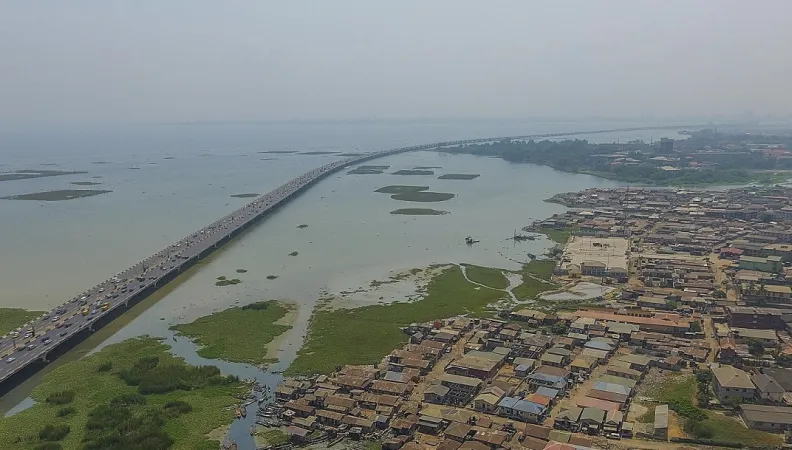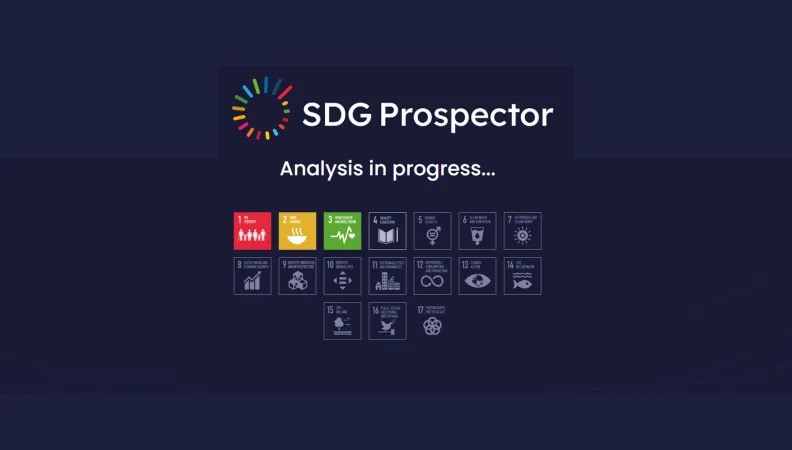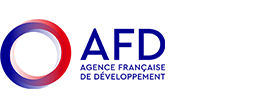 The coastline of the Gulf of Guinea is lowly elevated and particularly vulnerable to sea level rise triggered by climate change. However, in some places, another important factor has to be taken into account to correctly assess the exposure of inhabitants and ecosystems: the gradual lowering of the land surface. The objective of this research program is to quantify this phenomenon and to understand drivers and processes, especially in coastal megacities and deltas.
The coastline of the Gulf of Guinea is lowly elevated and particularly vulnerable to sea level rise triggered by climate change. However, in some places, another important factor has to be taken into account to correctly assess the exposure of inhabitants and ecosystems: the gradual lowering of the land surface. The objective of this research program is to quantify this phenomenon and to understand drivers and processes, especially in coastal megacities and deltas.
Context
The densely populated and lowly elevated coastline of the Gulf of Guina is particularly exposed to coastal erosion and sea-level rise. The entire coastline is currently experiencing alarming erosion rates, ranging from 1 to 15 meter per year between Côte d’Ivoire and Nigeria, mostly because of human activities. The problem is well studied and various programs aim to put in place coastal protection measures. By contrast mid- and long-term vulnerability to sea-level rise triggered by climate change has received less attention in this region.
In addition, to assess the various risks induced by sea-level rise, it is also necessary to consider land surface movements. The gradual lowering of the land surface in some places is called subsidence. The phenomenon is widespread at the global scale, especially in coastal megacities and deltas: 51 to 71% of present-day relative sea-level rise experienced by people worldwide is actually caused by subsidence. The rate can reach several centimeters per year in some places, however coastal subsidence is globally critically under-quantified, and the Gulf of Guinea region is no exception to this.
Objectives
This research program aims to fill the lacune in knowledge on coastal land subsidence and relative sea-level rise along the Gulf of Guinea. It will provide useful space-borne quantifications of current coastal subsidence rates, assess the driving forces of land subsidence and provide first projections of potential future subsidence using numerical models.
Impact will further be created by collaborating with local institutes, connecting to other projects and disseminating findings, data and tools to local stakeholders.
One of the long-term objectives is also to create awareness and agenda setting of this issue of relative sea-level rise in the region, in order to support sustainable development or adaptation projects in coastal areas and policymaking in the region.
Method
The first working group will assess current subsidence rates for the whole coastline, using satellite data to monitor vertical land movement over several years. The results will be combined to satellite elevation data to provide a first assessment of the areas that could be flooded in future decades.
The second working group will focus on the city of Lagos and surroundings, to provide an in-depth analysis of subsidence and to understand drivers and processes. The research team will build a process-based numerical model of subsidence to provide projections of future subsidence rates according to different scenarios.
Then, the methods developed for Lagos will also be applied to 3 or 4 other areas, coastal megacities or deltas, identified as “hotspots” for relative sea-level rise by the first working group.
Knowledge exchange events (seminars and workshops) will also be regularly organized, to disseminate research findings and build a regional community of interest on subsidence and relative sea-level rise.
Results
Results will be shared through scientific papers, technical reports, on-line databases and policy briefs. They will provide valuable information for policymakers and coastal (infrastructural) development projects potentially impacted by relative sea-level rise. In particular, results will help to better calibrate coastal adaptation measures and may also identify areas where the efficiency of natural coastal defences could fail in the future. Understanding the drivers of subsidence will also help to identify potential mitigation measures. The project will also foster public policy dialogue on coastal vulnerability, to favor adaptation projects.
In November 2023, a Research Conversations webinar provided an overview of the current state of knowledge on these issues in the region. The replay is available below:
The ENGULF project team then organized a webinar series to present the main findings of the ENGULF project. The replays are available below.
- Session 1: "Sinking Shores, Rising Concerns: Coastal Land Subsidence and its Implications for the Future of Ghana's Volta Delta" (April 4, 2024). Prof. Kwasi Appeaning Addo and Dr. Selasi Yao Avornyo presented their research work carried out at the University of Ghana.
- Session 2: "Insights into Increasing Land Subsidence along Nigeria's Gulf Coast" (May 2, 2024). Dr. Femi Ikuemonisan presented his research work carried out at the Lagos State University of Education (Lagos, Nigeria).
- Session 3: "Unraveling Gulf of Guinea's land subsidence dynamics using InSAR post-processing insights". Dr. Roberta Boni presented her research work carried outa at the University School for Advanced Studies IUSS Pavia (Italy).
A West African international workshop, organised in November 2024 in Ghana, focused on the challenges of coastal land subsidence. The summary video is available by clicking here.
Download the final report
- Comment évaluer les risques d'inondation dans les zones côtières de basse altitude où on manque de données ? La précision des données sur l'élévation est déterminante (April 2024)
- A scoping study on coastal vulnerability to relative sea-level rise in the Gulf of Guinea: Coastal elevation and literature review (June 2023)
- A scoping review of the vulnerability of Nigeria's coastland to sea-level rise and the contribution of land subsidence (June 2023)
- Vulnerability of Ghana's coast to relative sea-level rise: A scoping review (June 2023)
- A scoping review of coastal vulnerability, subsidence and sea level rise in Ghana: Assessments, knowledge gaps and management implications (Quaternary Science Advances, October 2023)
- The contribution of coastal land subsidence to potential sea-level rise impact in data-sparse settings: The case of Ghana’s Volta delta (Quaternary Science Advances, June 2024).
Contacts
- Marie-Noëlle Woillez, research officer on climate change impacts, AFD
- Marine Canesi, research officer, AFD
 Faced with major social and environmental transitions, an increasing number of companies and institutions are called upon to account for the extra-financial impacts of their activities. The SDG Prospector applies artificial intelligence (AI) methods to map the alignment of public development banks (PDBs) to the 17 Sustainable Development Goals (SDGs). An innovative solution to better understand the role of PDBs in sustainable finance.
Faced with major social and environmental transitions, an increasing number of companies and institutions are called upon to account for the extra-financial impacts of their activities. The SDG Prospector applies artificial intelligence (AI) methods to map the alignment of public development banks (PDBs) to the 17 Sustainable Development Goals (SDGs). An innovative solution to better understand the role of PDBs in sustainable finance.
Context
522 is the number of public development banks identified to date (Xu et al, 2021) that make up the Finance in Common global coalition. Responsible for around 10% of the world’s annual investment, these institutions play an essential role in the international financial architecture. With a mandate and public responsibility, they provide financial support in sectors where social and/or environmental profitability is greater than private profitability, such as health, education and the fight against climate change. Thus, they are called to play a decisive role in achieving the 2030 Agenda.
Some public development banks (PDBs) analyse their alignment with the SDGs, but the use of disparate methods does not yield reliable and comparable results. At the same time, the majority of PDBs publish an annual activity and sustainable development report. These documents, available online, are a wealth of information today little exploited and on which we rely in our project.
Goal
This research project led by AFD aims to test the potential of artificial intelligence (AI) technologies for the benefit of sustainable development. It resulted in the creation of the SDG Prospector, a tool that offers a unified and relevant method to map the extra-financial commitments of public development banks. It quantifies the degree of importance given to each of the 17 Sustainable Development Goals in official PDBs documentation.
The analysis was conducted over a five-year period (2016-2020) for 237 institutions. Thus, it is possible to draw up an overview of the SDG alignment by bank, geographies, size of balance sheets, mandates, levels of development, etc.
Read also: Using Artificial Intelligence to assess progress towards the Sustainable Development Goals
Method
In order to extract the information contained in the annual reports of public development banks, the SDG Prospector applies an artificial intelligence method specialized in language analysis (Natural Language Processing). This innovative technique is more accurate than a keyword analysis, as it allows the tool to recognize the context of sentences.
To do this, the SDG Prospector relies on a learning base, which allows it to identify when a text mentions the SDGs and to determine which SDG it is. The learning base consists of more than 8,500 texts related to the 2030 Agenda, mainly from United Nations documents, government reports and NGOs. Specializing in the recognition of SDGs, the Prospector divides each annual report into paragraphs of about ten lines and determines whether there is mention of one, several or no SDGs.
Results
The results allow to draw an extensive mapping of PDBs’ positioning towards the 2030 Agenda:
- PDBs strategic and operational narrative is mainly structured around the SDGs, such as SDG 8 “Decent Work and Economic Growth” and SDG 9 “Innovation and Infrastructure”;
- SDG 13 “Climate Action” is increasingly taken into account by the entire sample, and we note a positive correlation between the size of PDBs’ balance sheet and their consideration for SDGs that are associated with environmental protection;
- Biodiversity constitutes a negligible part of PDBs’ narrative;
- Social SDGs account for 21% of PDBs’ annual reports. However, cross-cutting SDGs such as gender equality, reduced inequalities and the eradication of poverty represent a minor share of PDBs’ narrative;
- PDBs that have similar characteristics in terms of size, mandate and geography tend to share the same SDG narrative.
Analyze your document with the SDG Prospector: sdgprospector.org
Lessons learned
The artificial intelligence techniques used allow new data to emerge, both for research and for the operational implementation of the SDGs. Other innovative projects followed by AFD contribute to this dynamic, in line with the IA-Biodiv Challenge.
Read our Research Paper: "The Proof is in the Pudding: Revealing the SDGs with Artificial Intelligence"
Contact:
- Régis Marodon, Special Advisor on sustainable finance at AFD
- Jean-Baptiste Jacouton, Research Officer at AFD
